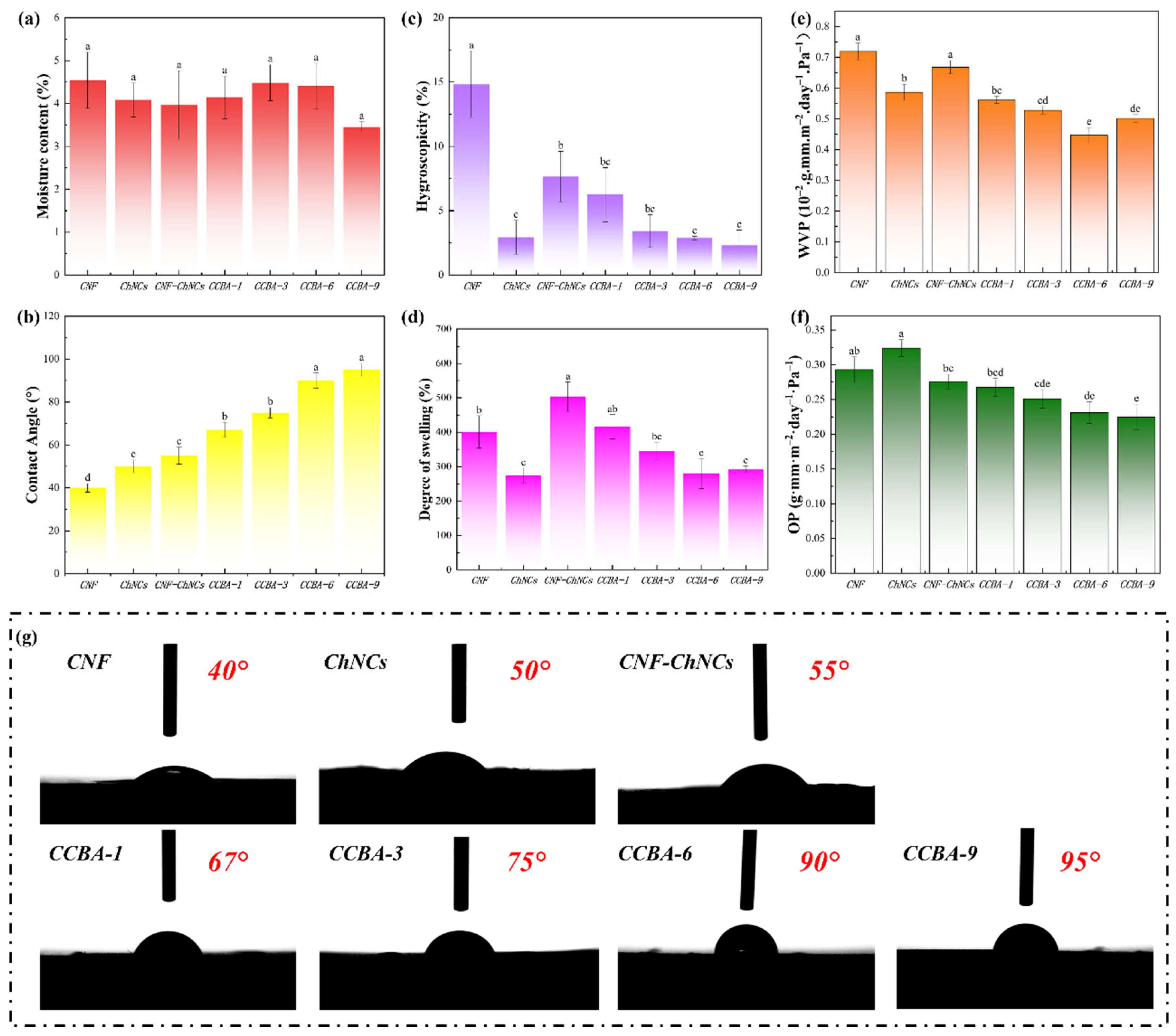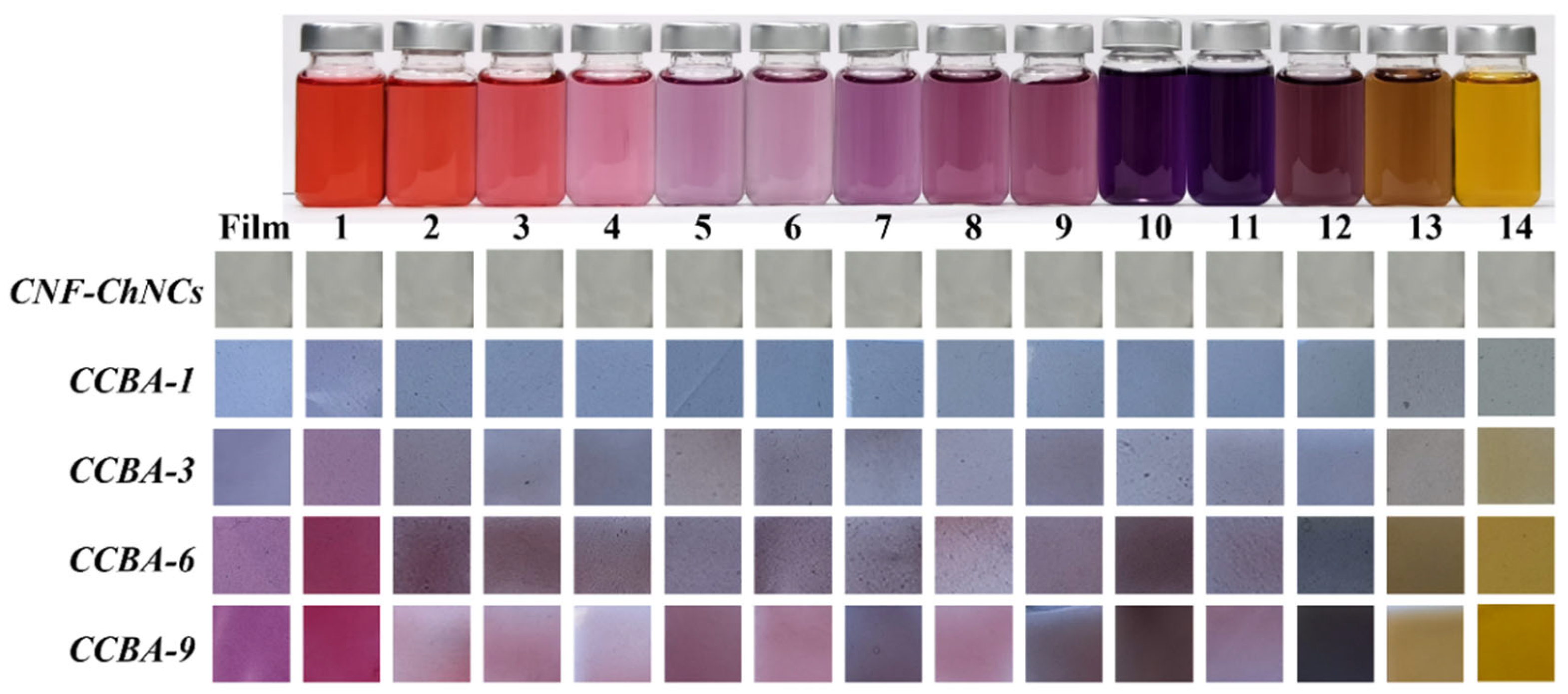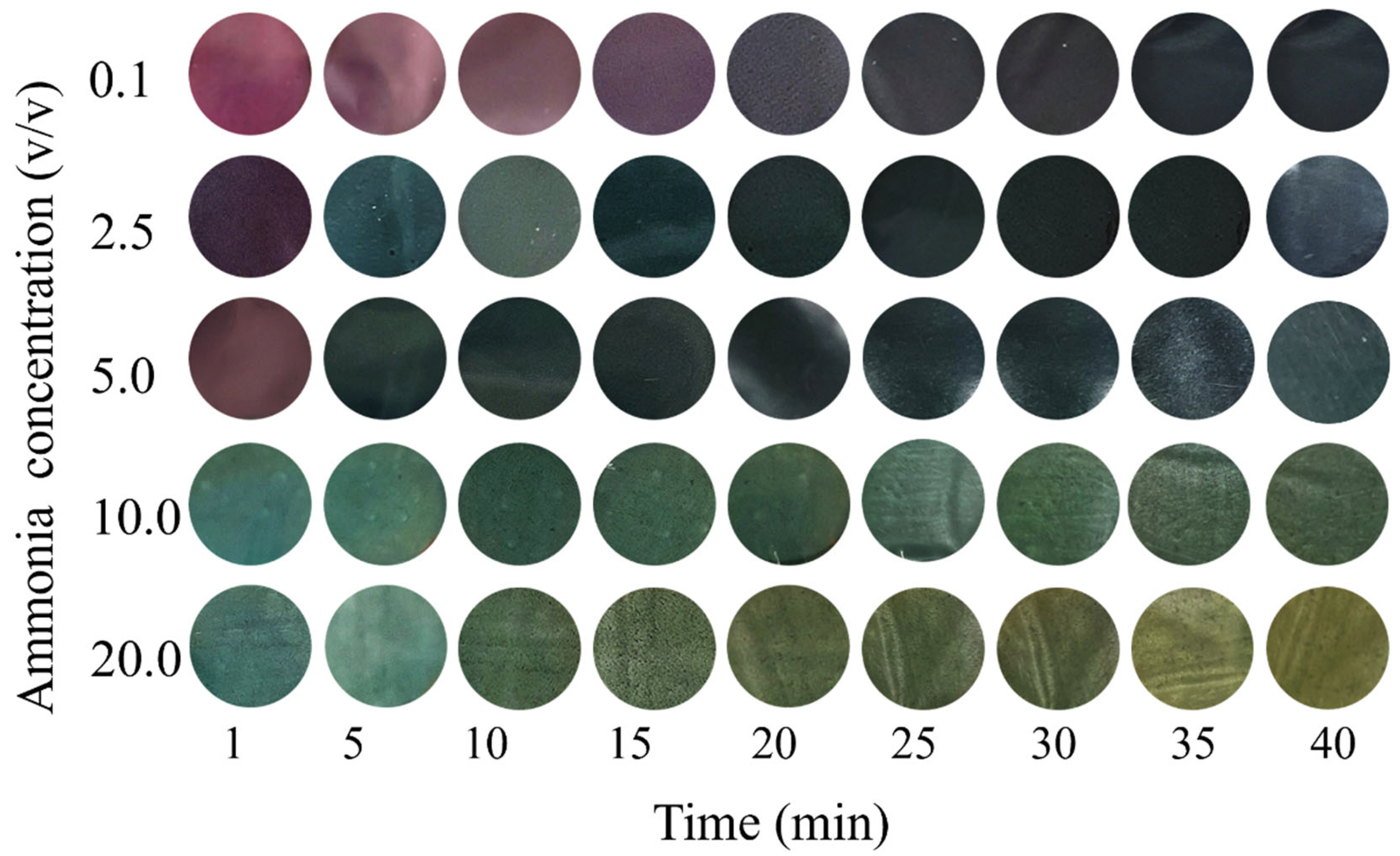Anthocyanin-Functionalized Hydrophobic Cellulose Composite Films as Sensitive Colorimetric Indicators to Monitor Beef Freshness
Abstract
1. Introduction
2. Materials and Methods
2.1. Materials
2.2. Preparation of ChNCs-Incorporated Nanocellulose Composite Films (Labeled as CNF-ChNCs Composite Films)
2.3. Preparation of BA/ChNCs-Incorporated Nanocellulose Composite Films (Labeled as CCBA-x Composite Films)
2.4. Characterization
2.4.1. Structural Characterization
2.4.2. Transparency and Stability Assay
2.4.3. Water Contact Angle (WCA) Test
2.4.4. Moisture Content (MC), Degree of Swelling (DS), and Hygroscopicity (HC)
2.4.5. Water Vapor Permeability (WVP) and Oxygen Permeability (OP)
2.4.6. Sensitivity to Ammonia
2.4.7. Sensitivity to pH Solutions
2.4.8. Antioxidant Activity
2.4.9. Antibacterial Activity
2.5. Degradation Test
2.6. Application in Beef Preservation
3. Result and Discussion
3.1. Overall Design of the System
3.2. Structure Characterization
3.3. Water-Repellency Performance of CCBA-x Composite Films
3.4. Antibacterial/Antioxidant Properties of Nanocellulose Composite Films
3.5. pH-Response and Ammonia-Sensitive Properties of CCBA-x Composite Films
3.6. Food Preservation
3.7. Whole Life Cycles of CCBA-x Composite Films
4. Conclusions
Supplementary Materials
Author Contributions
Funding
Institutional Review Board Statement
Informed Consent Statement
Data Availability Statement
Acknowledgments
Conflicts of Interest
References
- Motelica, L.; Ficai, D.; Ficai, A.; Oprea, O.C.; Kaya, D.A.; Andronescu, E. Biodegradable Antimicrobial Food Packaging: Trends and Perspectives. Foods 2020, 9, 1438. [Google Scholar] [CrossRef]
- Zhu, M.; Wang, Y.; Zhu, S.; Xu, L.; Jia, C.; Dai, J.; Song, J.; Yao, Y.; Wang, Y.; Li, Y.; et al. Anisotropic, Transparent Films with Aligned Cellulose Nanofibers. Adv. Mater. 2017, 29, 1606284. [Google Scholar] [CrossRef]
- Zhang, C.; Yang, X.; Li, Y.; Wang, S.; Zhang, Y.; Yang, H.; Chai, J.; Li, T. Multifunctional Hybrid Composite Films Based on Biodegradable Cellulose Nanofibers, Aloe Juice, and Carboxymethyl Cellulose. Cellulose 2021, 28, 4927–4941. [Google Scholar] [CrossRef]
- Mujtaba, M.; Akyuz, L.; Koc, B.; Kaya, M.; Ilk, S.; Cansaran-Duman, D.; Martinez, A.S.; Cakmak, Y.S.; Labidi, J.; Boufi, S. Novel, Multifunctional Mucilage Composite Films Incorporated with Cellulose Nanofibers. Food Hydrocoll. 2019, 89, 20–28. [Google Scholar] [CrossRef]
- Zhang, X.; Pu, H.; Sun, D.-W. Green and Scalable Synthesis of Chitin Nanocrystals via Microwave-Assisted Hydrolysis Using Recyclable Ferric Chloride Hexahydrate. ACS Sustain. Chem. Eng. 2025, 13, 16091–16106. [Google Scholar] [CrossRef]
- Liu, Y.; Xu, H.; Chen, Z.; Xie, Z.; Wen, H.; Chang, X.; Li, G. Development of Lily Starch Films Reinforced with Chitosan–Honeysuckle Essential Oil Hybrid Particles and Cellulose Nanofibers for Enhanced Properties. Foods 2025, 14, 589. [Google Scholar] [CrossRef]
- Sun, J.; Yang, X.; Bai, Y.; Fang, Z.; Zhang, S.; Wang, X.; Yang, Y.; Guo, Y. Recent Advances in Cellulose Nanofiber Modification and Characterization and Cellulose Nanofiber-Based Films for Eco-Friendly Active Food Packaging. Foods 2024, 13, 3999. [Google Scholar] [CrossRef] [PubMed]
- Ardyani, T.; Mohamed, A.; Abu Bakar, S.; Sagisaka, M.; Umetsu, Y.; Hafiz Mamat, M.; Khairul Ahmad, M.; Abdul Khalil, H.P.S.; King, S.M.; Rogers, S.E.; et al. Electrochemical Exfoliation of Graphite in Nanofibrillated Kenaf Cellulose (NFC)/Surfactant Mixture for the Development of Conductive Paper. Carbohydr. Polym. 2020, 228, 115376. [Google Scholar] [CrossRef]
- Xie, W.; Li, T.; Tiraferri, A.; Drioli, E.; Figoli, A.; Crittenden, J.C.; Liu, B. Toward the Next Generation of Sustainable Membranes from Green Chemistry Principles. ACS Sustain. Chem. Eng. 2021, 9, 50–75. [Google Scholar] [CrossRef]
- Liu, D.; Ma, J.; Wang, X.; Liu, F. High-Strength and High-Toughness Tannic Acid-Modified Cellulose Films for Food Preservation. J. Mater. Sci. 2024, 59, 17769–17781. [Google Scholar] [CrossRef]
- Li, C.-Y.; You, J.-L.; Liu, I.-T.; Istiqomah, A.; Liao, Y.-C. Mercerized Bacterial Cellulose/Chitosan/Waterborne Polyurethane Composites for Sustainable and Effective Food Preservation Packaging. Chem. Eng. J. 2025, 512, 162332. [Google Scholar] [CrossRef]
- Ji, C.; Wang, Y. Lignin-Containing Cellulose Nanocrystals from Maple Leaves: A Natural Pickering Emulsion Stabilizer for Food Preservation. Food Chem. 2025, 463, 141407. [Google Scholar] [CrossRef]
- Chen, J.; Liu, X.; Li, Z.; Cao, F.; Lu, X.; Fang, X. Work—Function—Tunable MXenes Electrodes to Optimize p-CsCu2 I3/n-Ca2 Nb3-x TaxO10 Junction Photodetectors for Image Sensing and Logic Electronics. Adv. Funct. Mater. 2022, 32, 2201066. [Google Scholar] [CrossRef]
- Li, R.; Yang, T.; Ding, M.; Yu, H.; Yang, S.; Pan, X.; Zhang, L.; Xie, H. Multifunctional Nanocomposite Packaging Films Enabled by Tannic Acid-Modified Chitin Nanocrystals for Fruit Preservation. Food Hydrocoll. 2026, 171, 111863. [Google Scholar] [CrossRef]
- Wen, R.; Liao, J. Surface-Deacetylated Nano-Chitin as Antibacterial Coating for Meat Preservation. Food Packag. Shelf Life 2025, 52, 101609. [Google Scholar] [CrossRef]
- Sun, J.; Zhou, Q.; Wei, Z.; Xue, C. Multifunctional Intelligent Indication Labels Featuring Antibacterial Properties Based on Pectin/Carboxymethyl Chitosan Incorporated with Porous Microspheres Loaded with Anthocyanins: A New Approach for Salmon Preservation and Freshness Detection. Food Hydrocoll. 2025, 158, 110571. [Google Scholar] [CrossRef]
- Guo, B.; Sun, Y.; Guan, Q.; Luo, Z.; Zhou, L.; Xu, Z.; Han, J.; Qu, D. Fabrication and Characterization of Sodium Alginate/Blueberry Anthocyanins/Hinokitiol Loaded ZIF-8 Nanoparticles Composite Films with Antibacterial Activity for Monitoring Pork Freshness. Food Chem. 2024, 440, 138200. [Google Scholar] [CrossRef]
- Tindal, R.A.; Jeffery, D.W.; Muhlack, R.A. Nonlinearity and Anthocyanin Colour Expression: A Mathematical Analysis of Anthocyanin Association Kinetics and Equilibria. Food Res. Int. 2024, 183, 114195. [Google Scholar] [CrossRef]
- Motelica, L.; Ficai, D.; Petrisor, G.; Oprea, O.-C.; Trușcǎ, R.-D.; Ficai, A.; Andronescu, E.; Hudita, A.; Holban, A.M. Antimicrobial Hydroxyethyl-Cellulose-Based Composite Films with Zinc Oxide and Mesoporous Silica Loaded with Cinnamon Essential Oil. Pharmaceutics 2024, 16, 1225. [Google Scholar] [CrossRef]
- Zhang, L.; Yu, D.; Gu, Y.; Xu, Y.; Jiang, Q.; Yang, F.; Regenstein, J.M.; Yu, D.; Xia, W. Green Halochromic Smart and Active Packaging Materials Based on Chitosan Film Loading Nanoparticles: Functionality, Physicochemical Properties and Application. Food Hydrocoll. 2024, 150, 109667. [Google Scholar] [CrossRef]
- Motelica, L.; Ficai, D.; Oprea, O.; Ficai, A.; Trusca, R.-D.; Andronescu, E.; Holban, A.M. Biodegradable Alginate Films with ZnO Nanoparticles and Citronella Essential Oil—A Novel Antimicrobial Structure. Pharmaceutics 2021, 13, 1020. [Google Scholar] [CrossRef] [PubMed]
- Chen, G.; Wang, K.; Chen, P.; Cai, D.; Shao, Y.; Xia, R.; Li, C.; Wang, H.; Ren, F.; Cheng, X.; et al. Fully Biodegradable Packaging Films for Fresh Food Storage Based on Oil-Infused Bacterial Cellulose. Adv. Sci. 2024, 11, 2400826. [Google Scholar] [CrossRef] [PubMed]
- Yar, M.S.; Ibeogu, I.H.; Bako, H.K.; Alnadari, F.; Bilal, M.; Rehman, F.; Zhu, J.; Zhou, T.; Zhao, Z.; Li, C. A Novel Carboxymethyl Cellulose/Gum Xanthan and Citric Acid-Based Film That Enhances the Precision of Blackcurrant Anthocyanin-Induced Color Detection for Beef Spoilage Tracking. Food Chem. 2024, 461, 140905. [Google Scholar] [CrossRef] [PubMed]
- Kim, J.-H.; Lee, E.-S.; Kim, B.-M.; Oh, M.-H. Potential Correlation between Microbial Diversity and Volatile Flavor Compounds in Different Types of Korean Dry-Fermented Sausages. Foods 2022, 11, 3182. [Google Scholar] [CrossRef]
- Bagri, F.; Pircheraghi, G.; Imani, M.; Riahi, Z.; Douraghi, M.; Rhim, J.-W. Active Packaging Film Based on Quince Seed Mucilage/Alginate Integrated with Biosilica Nanoparticles Containing Oak Extract for Extending the Shelf Life of Meat. Food Packag. Shelf Life 2025, 48, 101466. [Google Scholar] [CrossRef]
- Bian, H.; Luo, D.; Shi, J.; Zhou, X.; Xu, T.; Xiao, H.; Dai, H.; Li, T.; Huang, C.; Ragauskas, A.J. Cellulose Nanofibrils-Based Packaging Films Synergistically Reinforced by Lignin and Tea Polyphenols for Strawberry Preservation. Chem. Eng. J. 2024, 502, 157843. [Google Scholar] [CrossRef]
- Wang, S.; Du, X.; Cheng, X.; Du, Z.; Zhang, Z.; Wang, H. Ultrahigh Stretchable, Highly Transparent, Self-Adhesive, and Environment-Tolerant Chitin Nanocrystals Engineered Eutectogels toward Multisignal Sensors. ACS Appl. Mater. Interfaces 2024, 16, 45537–45549. [Google Scholar] [CrossRef]
- Rashwan, A.K.; Karim, N.; Xu, Y.; Xie, J.; Cui, H.; Mozafari, M.R.; Chen, W. Potential Micro-/Nano-Encapsulation Systems for Improving Stability and Bioavailability of Anthocyanins: An Updated Review. Crit. Rev. Food Sci. Nutr. 2023, 63, 3362–3385. [Google Scholar] [CrossRef]
- Zhang, X.; Jia, Y.; Ma, Y.; Cheng, G.; Cai, S. Phenolic Composition, Antioxidant Properties, and Inhibition toward Digestive Enzymes with Molecular Docking Analysis of Different Fractions from Prinsepia Utilis Royle Fruits. Molecules 2018, 23, 3373. [Google Scholar] [CrossRef]
- Pan, X.; Chen, G.; Xu, T.; Kong, L.; Li, X.; Li, D.; Mu, C.; Xu, Z.; Ge, L. Gelatin-Based Active Edible Film with pH-Sensing for Maintaining and Monitoring Fish Freshness. ACS Food Sci. Technol. 2023, 3, 1366–1375. [Google Scholar] [CrossRef]
- Li, J.; Bao, Y.; Li, Z.; Cui, H.; Jiang, Q.; Hou, C.; Wang, Y.; Wu, Y.; Shang, J.; Xiao, Y.; et al. Dual-Function β-Cyclodextrin/Starch-Based Intelligent Film with Reversible Responsiveness and Sustained Bacteriostat-Releasing for Food Preservation and Monitoring. Int. J. Biol. Macromol. 2023, 253, 127168. [Google Scholar] [CrossRef]
- Ezati, P.; Khan, A.; Rhim, J.-W.; Kim, J.T.; Molaei, R. pH-Responsive Strips Integrated with Resazurin and Carbon Dots for Monitoring Shrimp Freshness. Colloids Surf. B Biointerfaces 2023, 221, 113013. [Google Scholar] [CrossRef]
- Holman, B.W.B.; Bekhit, A.E.-D.A.; Waller, M.; Bailes, K.L.; Kerr, M.J.; Hopkins, D.L. The Association between Total Volatile Basic Nitrogen (TVB-N) Concentration and Other Biomarkers of Quality and Spoilage for Vacuum Packaged Beef. Meat Sci. 2021, 179, 108551. [Google Scholar] [CrossRef]
- Liu, Z.; Wang, S.; Liang, H.; Zhou, J.; Zong, M.; Cao, Y.; Lou, W. A Review of Advancements in Chitosan-Essential Oil Composite Films: Better and Sustainable Food Preservation with Biodegradable Packaging. Int. J. Biol. Macromol. 2024, 274, 133242. [Google Scholar] [CrossRef]
- Chen, Y.; Li, Y.; Qin, S.; Han, S.; Qi, H. Antimicrobial, UV Blocking, Water-Resistant and Degradable Coatings and Packaging Films Based on Wheat Gluten and Lignocellulose for Food Preservation. Compos. Part B Eng. 2022, 238, 109868. [Google Scholar] [CrossRef]









| Sample Code | CNF/ChNCs Matrix (Dry Mass Ratio) | BA (wt%) |
|---|---|---|
| CNF | 100/0 | 0 |
| ChNCs | 0/100 | 0 |
| CNF-ChNCs | 50/50 | 0 |
| CCBA-1 | 50/50 | 1 |
| CCBA-3 | 50/50 | 3 |
| CCBA-6 | 50/50 | 6 |
| CCBA-9 | 50/50 | 9 |
| Time (h) | CK | PE | CCBA-9 | |
|---|---|---|---|---|
| pH | 0 | 5.67 ± 0.02 bcA | 5.67 ± 0.02 bcA | 5.67 ± 0.02 cA |
| 12 | 5.48 ± 0.1 cA | 5.53 ± 0.12 cA | 5.53 ± 0.12 cA | |
| 24 | 5.66 ± 0.18 bcA | 5.76 ± 0.23 bcA | 5.93 ± 0.24 cA | |
| 36 | 6 ± 0.42 bB | 6.11 ± 0.67 bAB | 6.47 ± 0.42 bA | |
| 48 | 6.49 ± 0.49 aB | 6.69 ± 0.32 aAB | 6.97 ± 0.78 aA | |
| Weight Loss Rate (%) | 12 | 7.43 ± 1.21 dA | 4.42 ± 0.55 cB | 6.47 ± 0.56 cA |
| 24 | 12.52 ± 2.26 cA | 5.81 ± 0.2 bB | 10.95 ± 0.72 bA | |
| 36 | 17.74 ± 2.12 bA | 7.1 ± 0.41 bB | 14.05 ± 2.54 bA | |
| 48 | 23.39 ± 2.12 aA | 10.91 ± 0.56 aB | 19.69 ± 0.9 aA | |
| TVC (log CFU/g)) | 0 | 3.68 ± 0.18 eA | 3.68 ± 0.01 eA | 3.68 ± 0.01 dA |
| 12 | 4.82 ± 0.16 dA | 3.97 ± 0.25 dB | 3.8 ± 0.16 dB | |
| 24 | 5.81 ± 0.51 cA | 4.52 ± 0.15 cB | 4.36 ± 0.36 cC | |
| 36 | 7.18 ± 0.34 bA | 6.38 ± 0.34 bB | 6.1 ± 0.34 bC | |
| 48 | 8.64 ± 0.09 aA | 7.51 ± 0.13 aB | 7.36 ± 0.67 aC | |
| TVB-N (mg/100 g) | 0 | 6.11 ± 0.31 eA | 6.11 ± 0.02 eA | 6.11 ± 0.01 eA |
| 12 | 9.5 ± 0.24 dA | 7.47 ± 0.15 dB | 6.5 ± 0.94 dC | |
| 24 | 14.23 ± 0.36 cA | 9.8 ± 0.32 cB | 8.51 ± 0.18 cC | |
| 36 | 21.7 ± 0.05 bA | 17.48 ± 0.15 bB | 16.95 ± 1.36 bC | |
| 48 | 26.95 ± 0.36 aA | 21.54 ± 1.02 aB | 21.06 ± 0.98 aC |
Disclaimer/Publisher’s Note: The statements, opinions and data contained in all publications are solely those of the individual author(s) and contributor(s) and not of MDPI and/or the editor(s). MDPI and/or the editor(s) disclaim responsibility for any injury to people or property resulting from any ideas, methods, instructions or products referred to in the content. |
© 2025 by the authors. Licensee MDPI, Basel, Switzerland. This article is an open access article distributed under the terms and conditions of the Creative Commons Attribution (CC BY) license (https://creativecommons.org/licenses/by/4.0/).
Share and Cite
Cai, X.; Li, C.; Mo, Y.; Qiao, M.; Xiang, J.; Wang, S.; Li, M. Anthocyanin-Functionalized Hydrophobic Cellulose Composite Films as Sensitive Colorimetric Indicators to Monitor Beef Freshness. Foods 2025, 14, 3944. https://doi.org/10.3390/foods14223944
Cai X, Li C, Mo Y, Qiao M, Xiang J, Wang S, Li M. Anthocyanin-Functionalized Hydrophobic Cellulose Composite Films as Sensitive Colorimetric Indicators to Monitor Beef Freshness. Foods. 2025; 14(22):3944. https://doi.org/10.3390/foods14223944
Chicago/Turabian StyleCai, Xuemei, Changqiu Li, Yujie Mo, Mingfeng Qiao, Jun Xiang, Shuang Wang, and Meifeng Li. 2025. "Anthocyanin-Functionalized Hydrophobic Cellulose Composite Films as Sensitive Colorimetric Indicators to Monitor Beef Freshness" Foods 14, no. 22: 3944. https://doi.org/10.3390/foods14223944
APA StyleCai, X., Li, C., Mo, Y., Qiao, M., Xiang, J., Wang, S., & Li, M. (2025). Anthocyanin-Functionalized Hydrophobic Cellulose Composite Films as Sensitive Colorimetric Indicators to Monitor Beef Freshness. Foods, 14(22), 3944. https://doi.org/10.3390/foods14223944







